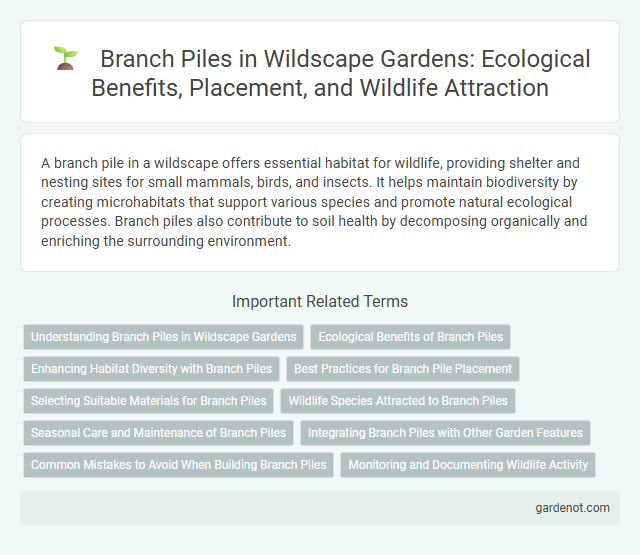A branch pile in a wildscape offers essential habitat for wildlife, providing shelter and nesting sites for small mammals, birds, and insects. It helps maintain biodiversity by creating microhabitats that support various species and promote natural ecological processes. Branch piles also contribute to soil health by decomposing organically and enriching the surrounding environment.
Understanding Branch Piles in Wildscape Gardens
Branch piles in Wildscape gardens serve as crucial habitats for diverse wildlife, promoting biodiversity by providing shelter and nesting sites for insects, amphibians, and small mammals. These natural structures help maintain ecological balance, support soil health through organic decomposition, and offer protective microclimates essential for species survival. Proper placement and periodic maintenance of branch piles optimize their effectiveness as wildlife sanctuaries within garden ecosystems.
Ecological Benefits of Branch Piles
Branch piles serve as vital microhabitats within wildscapes, offering shelter and nesting sites for diverse wildlife species such as birds, small mammals, and insects. These natural structures enhance soil health by promoting decomposition and nutrient cycling, thereby supporting plant growth and biodiversity. By stabilizing the ecosystem and providing refuge from predators and harsh weather, branch piles contribute significantly to ecological resilience and habitat complexity.
Enhancing Habitat Diversity with Branch Piles
Branch piles create essential microhabitats that increase shelter and nesting opportunities for a variety of wildlife species. They support biodiversity by providing cover for small mammals, reptiles, and insects while also aiding soil health through natural decomposition processes. Integrating branch piles within Wildscape designs promotes ecological balance and enhances overall habitat complexity.
Best Practices for Branch Pile Placement
Branch pile placement in wildscaping should prioritize natural habitat creation by situating piles in shaded, damp areas to attract wildlife such as amphibians and insects. The size and orientation of branch piles impact shelter quality, with loosely stacked branches allowing easy access and ventilation while preventing waterlogging. Positioning near ponds, woodlands, or along hedgerows enhances biodiversity by connecting habitats and supporting ecological corridors.
Selecting Suitable Materials for Branch Piles
Selecting suitable materials for branch piles in wildscape projects involves prioritizing native, non-toxic wood to support local biodiversity and ensure environmental compatibility. Branches should be free from chemicals, disease, and invasive species to promote natural decomposition and provide habitat for wildlife like insects, amphibians, and small mammals. Properly sized and arranged materials enhance soil stability and moisture retention, critical factors for fostering a thriving wildscape ecosystem.
Wildlife Species Attracted to Branch Piles
Branch piles provide essential shelter and foraging opportunities for diverse wildlife species such as small mammals, amphibians, and various bird species. These habitats offer protection from predators and harsh weather, supporting species like hedgehogs, frogs, and wrens. Creating branch piles enhances biodiversity by fostering microhabitats critical for insects, reptiles, and ground-nesting birds.
Seasonal Care and Maintenance of Branch Piles
Branch piles require seasonal care to prevent decay and promote habitat benefits for wildlife. Regular turning and aeration during spring and fall help maintain moisture balance and reduce fungal growth, while removing excess debris in winter prevents pest infestations. Proper seasonal maintenance ensures branch piles remain effective shelters for small animals and beneficial insects throughout the year.
Integrating Branch Piles with Other Garden Features
Integrating branch piles with other garden features enhances biodiversity by providing shelter for small wildlife and decomposers. Positioning branch piles near flower beds or water features creates microhabitats that support beneficial insects and amphibians. Using natural materials like branches alongside ponds or rock gardens promotes ecological balance within wildscape designs.
Common Mistakes to Avoid When Building Branch Piles
When building branch piles in Wildscape, avoid stacking branches too tightly, which can limit airflow and increase the risk of rot. Ensure branches are layered in a loose, crisscross pattern to promote decomposition and provide habitats for wildlife. Steer clear of using treated or painted wood, as chemicals can harm beneficial insects and soil microorganisms.
Monitoring and Documenting Wildlife Activity
Branch piles serve as critical habitats for diverse wildlife species, offering shelter and foraging opportunities that support ecosystem health. Monitoring involves systematic observation using trail cameras and direct field surveys to record species presence, behavior, and seasonal activity patterns. Documenting wildlife activity through detailed logs and photographic evidence aids in tracking biodiversity changes and informs conservation strategies effectively.
Branch pile Infographic

 gardenot.com
gardenot.com